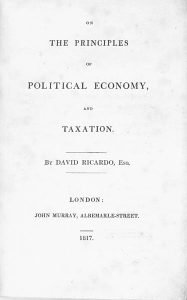One of the most classic works in economic literature —that usually implies it’s much more quoted than it is read— was published in 1817: On the Principles of political economy and taxation by David Ricardo. The seventh chapter contains the first formulation of the argument of comparative advantages as an explanation of the benefits of international trade that, two centuries later, is still taught in every school of economics around the world. In this era of globalization, the defenders of efficiency gains derived from open markets often take this explanation from two centuries ago as an initial reference. Another of Ricardo’s messages is, as he emphasizes from the first paragraphs in the prologue of his book, the key role of how wealth generated by the cooperation of production factors is distributed among them as an object of study in political economy. Thus trade and distribution are two central and linked dimensions. In a world like today’s, where the frictions generated by inequality problems are business as usual and even serve as a breeding ground for anti-trade and globalization approaches, it’s worth recalling the British financier, economist and parliamentarian David Ricardo’s messages.

PRODUCTION AND DISTRIBUTION
One of the successes of Ricardo’s Principles and that at first could seem dubious but implies exceptional acknowledgement, is that they became the reference against which to compare political economy approaches which were to be presented as an alternative. This is what marginalists did since 1870, and also John M. Keynes: Ricardo is the first author mentioned in General Theory (1936), in which he formulates the Keynesian expositions as opposed to the “theory that culminated in Ricardo” and which, following Marx, he called “classical economy”. But even with this tendency —which happens too often— of simplifying the adversary to revalue one’s own position, Keynes acknowledges it is necessary to distinguish between “Ricardian tradition” and Ricardo’s original formulations, with special emphasis on the central point of how production and distribution are inseparable. Keynes refers to a letter Ricardo wrote to Malthus —an epistolary exchange that is still worth reading today— in October 1820 in which Ricardo insists that “the true object of [economic] science” is that of “relative portions”.

In fact, the main instigator of the Principles published in 1817 was James Mill —John Stuart Mill’s father— who urged Ricardo to expand a booklet published in 1815 and commonly known as An Essay on Profit, with a complete title that referred to the effects of a low cereal price on profits and, in general, on the distribution of income among landowners, workers and industrialists. In 1815, the discussion and approval of corn laws, which introduced a significant degree of protectionism and penalized imports of cheaper cereals that competed with British production, triggered many controversies. The debates showed that behind the opposed positions of free trade advocates and protectionism supporters, there were not only economic interests, but also sociopolitical and “society model” ones. In his 1815 text, Ricardo eagerly criticized a protectionism that benefited British landowners: “I deeply regret that the interests of a certain class are allowed to impede the progress of the country’s wealth and population.” Ricardo was a firm believer of the progress the technological innovation of the Industrial Revolution meant, and stressed the importance of having sufficient resources to finance this new dynamic. He believed that this could be more easily achieved with unrestricted imports of cheap cereals which —by lowering the food costs that then meant a much more substantial part of people’s incomes than our supermarket bills do now— could help control de increase in wage costs and allow industrial profits that, properly reinvested, could mean the modernization of the economy and society. Thus, there was a background to the debates on free trade or protectionism which was a socio-political struggle between the traditional landowning aristocracy and the emerging industrial bourgeoisie.
UNIVERSAL SYSTEM OF COMMERCE
Ricardo’s argument in favour of trade openness contained aspects of general and more specific formulations. Among his most pompous statements, there is an application of the principles of Adam Smith’s “invisible hand” in commerce: “a perfectly free trading system” where each country seeks its own interest “connects admirably with the universal good of the whole…” general benefit is distributed and links “the universal society of nations throughout the civilized world”, as we can read in the seventh chapter of his Principles. On a more specific level, Ricardo’s texts are full of comparisons between the positive effects of technological progress and international trade. In fact, it is the two mechanisms presented as the most powerful to overcome the famous and feared tendency to diminishing returns, especially in working the land to grow food products.
Less well-known is Ricardo’s idea that the most notable benefits of international trade are related to the possibility of lowering the prices of basic products that are consumed by the most modest sectors of society, mainly workers. This would help maintain the purchasing power of wages (real wages) with modest variations in nominal wages, and the consequent positive effect on industrial profits. In a situation like the one we’ve been in for the last decades in which the modest evolution of salaries —even the stagnation of some indicators— has been the subject of controversy, and in which the role of “cheap imports” often coming from Asian economies has allowed to maintain some purchasing power standards, Ricardo’s arguments from two centuries ago still seem very applicable. This is precisely one of the most recent controversies: whether the effects of international trade have been pro-poor —increasing the purchasing power of those with lower incomes— or if the effects desired by Ricardo have not happened, with the analysis of conflicting results. In any case, a remarkable aspect of the Ricardian formulations is that international trade profits are initially sought by means of cheap imports, and not so much —or at least not mainly or exclusively— by encouraging exports. In fact, some recent formulations which often state that cheap and efficient imports enable subsequent exports by becoming more competitive in different industries would perfectly fit in Ricardo’s approach. The role of “imports to boost exports” contributes to dissipate a Manichean contraposition between exports and imports that we often hear about and that threatens to lead to rebounds of mercantile or protectionist temptations.
COMPARATIVE ADVANTAGES
The famous theory of comparative advantages as an explanation of why it is better for countries to specialize and trade than to try to be self-sufficient has a weak spot, which applies to situations where there is no country more efficient than another for each good, just that one particular country can be more productive in a wide range of sectors. In the early nineteenth century, the difference between England, that were going through the Industrial Revolution and other countries that hadn’t yet started theirs, made producing almost any product in England more efficient. Did that impede the possibility of an international trade that all participants could benefit from? The great analytical contribution of Ricardo was to prove that, even in this case, it was beneficial towards all participants —and the international economy— for the most productive country to specialize in the product with which they had a margin of superior advantage —comparative advantage— and leave specialization in another products which didn’t need special technological advances to other less advanced countries. As a classic example for this argument is his recommendation that England should produce textiles and let Portugal produce wines. One implication of this formulation is its “political correctness”: even countries at the lowest technological level have a place in the international division of labour. The presentation of international trade as a “positive-sum game” in which all participants can win —despite their asymmetries— has become one of the powerful arguments in favour of an open commercial system, in clear contrast to the formulations that see a mechanism of exploitation or “unequal exchange” in international trade. But we have to remember that distributive aspects are —in addition to efficiency gains— central to Ricardo’s proposals. Beyond trade and distribution issues, in the third edition of his Principles, in 1821, Ricardo introduced a new chapter on “the subject of machinery”: he expressed his doubts about whether the benefits of the growing introduction of machines would reach all segments of society. Something that, almost two centuries later, is still applicable today.





















